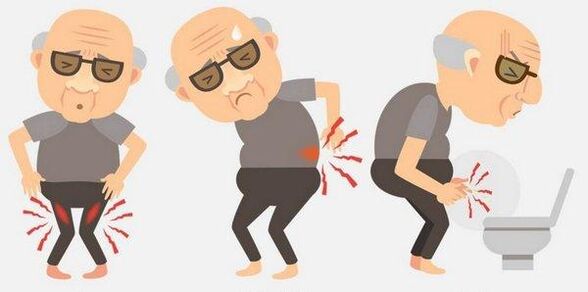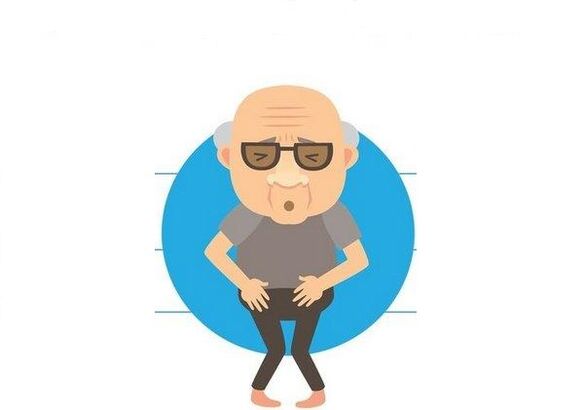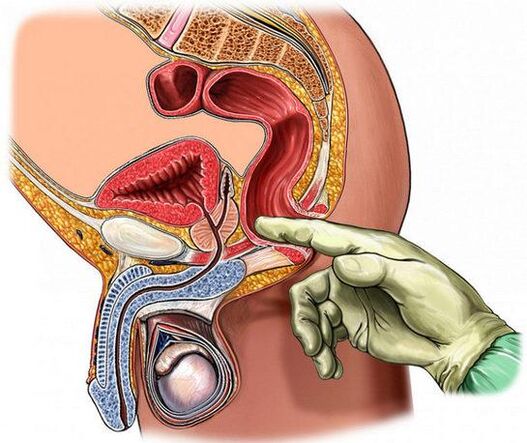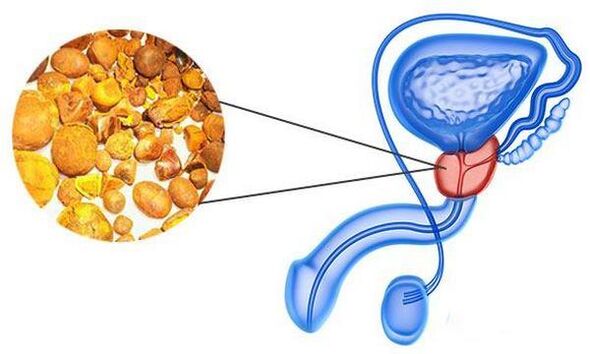Symptoms of prostatitis depend on the form and causes of inflammation of the prostate gland, as well as the presence of concomitant diseases. Symptoms usually intersect, which significantly complicates the diagnosis.

Chronic prostatitis
Chronic prostatitis develops as an independent disease or as a complication of the acute form of inflammation. During remission, symptoms are weak or completely absent, with exacerbation, they become more pronounced. The clinical picture resembles acute prostatitis.
The first symptoms of the chronic form of inflammation:
- Frequent desire for urination;
- Stupid pains in the lower abdomen;
- Discomfort in the prostate area (testicle area to the anus) with a long stay in the sitting position. Subsequently, sitting for more than an hour is impossible due to burning;
- Intermittent and painful urination;
- Dull pain in the rectum during defecation;
- It is possible to deteriorate an erection, it is possible to discomfort in the groin during ejaculation.
The above signs in the chronic form of prostatitis do not manifest themselves at once. Initially, this can be a lubricated orgasm, premature ejaculation, so a man has to strive during urination, the pain gradually joins.
In an ultrasound with chronic inflammation, a decrease in the density of prostate tissues is observed, an increase in the degree of reflection of the tissue wave. In some places, it decreases in the presence of cysts or intensifies in places of exposure to calcine (stones), sclerosis foci (connective tissue sealing, formed due to recovery processes after acute inflammation). In the final stages of connective tissue and fibrosis focuses, there are increasing. The size of the prostate gland is reduced. During visual diagnosis, it is difficult to distinguish it from the surrounding fiber.
Acute prostatitis
The acute form of infectious (bacterial) prostatitis is characterized by rapid development. The severity of symptoms depends on the degree of damage to the gland. With a catarral shape (inflammation affects only ducts), a man can only feel a slight discomfort during the stress of the inguinal region. During an examination of iron fingers, it is slightly increased and almost painless.
Follicular (purulent inflammation of individual gland lobes), papnchymate (inflammatory lesion of all prostate tissues) and abscess (capsules with purulent content are formed) formed forms are manifested by a whole complex of symptoms:

- Strengthy groin shot pain, giving in the rectum, testicles, sacred, in the internal hips of the hips, in the penis.
- Fever, general weakness. The active development of pathogens causes body intoxication with inflammatory products.
- Grazes when urinating, a feeling of incomplete emptying of the bladder (due to sphincters irritation and urethral mucosa).
- Purulent urethra discharge (pus leaves the prostate ducts, opening to the urethra).
- Feeling of gravity in the perineum.
- Quick heartbeat attacks.
- Urine of the worm with purulent wires. Blood may appear.
With a parenchymous form of prostatitis, painful cramps and pulsating pain in the rectum make it difficult for defection. Small relief occurs only in a pose lying with pressed legs. Often the inflammation of the prostate extends to the rectum, so the mucus begins to be extracted from the anus. Braking against the background in a paradise can stop completely due to severe gland edema.
External signs of acute ultrasound prostatitis:
- Expansion of venous plexuses. The vascular pattern is more clearly expressed;
- Expansion of the gland ducts and capsule (swelling, unequal increase, stab of contours);
- Increased degree of fabric wave reflection;
- The seed bubbles on the sides of the prostate are asymmetrical due to heterogeneous filling, the seeds that remove the seed are expanded.
With suspicious neoplasms, magnetic resonance imaging or CT is prescribed.
Stagnant prostatitis
The stagnation of prostatitis (is also called bacterial in the absence of infections) can develop in young men and more advanced. The main symptoms are similar to infectious chronic inflammation. A distinct feature is that the discomfort of the urinary system manifests and improved mainly due to long -term sexual abstinence. An exacerbation can cause violent extent of sexual intercourse, a non -core orgasm (proper emotional dye sex). FAR, painful urination (wandering) is usually observed in the morning. However, if the previous day was a complete orgasm, there are no cramps.
With this kind, prostatitis is the amount of leukocytes in the secret of the gland does not exceed the norm, there is no pathogenic flora in the third portion of the urine.
Calculate Prostatitis
Calculated prostatitis has no specific symptoms. The very presence of stones (Calcina) in the gland does not mean the automatic development of its inflammation. With physical effort, background pains can intensify. The migration of stones through the ducts sometimes causes the appearance of blood in the urine.
During a prostate ultrasound, calcincts are detected. Due to increased density, they more efficiently reflect the waves emitted by the device.
Characteristics of manifestation of prostatitis of young and mature

Symptoms of various forms of prostatitis do not depend on a man's age category. Young people are actively living their sex life, so more often develop an acute form of infectious inflammation with corresponding pronounced signs.
Chronic prostatitis is diagnosed in men a few years after the onset of sexual activity. During this period, due to the activity of hidden infections, the prostate structure is violated, its cellular immunity is reduced. Symptoms appear at a time when pathological changes are already irreversible.
Maduro men suffer mainly from urination disorders, periodic stupid pain in the perineum and erection disorders. Licking prostatitis at this age is aggravated by stagnant processes in pelvis at the bottom of androgenic failure and loss of muscle tone.
When and for those who contact
Any of the above symptoms is the reason for contacting the urologist or andrologist (diagnosis of prostatitis under clinical and domestic conditions). Many men avoid going to the doctor because of a negative attitude for prostate examination with a finger through the anus or trusie (transrectal ultrasound). If the patient categorically refuses these types of studies, the doctor will offer transabdominal ultrasound - when the sensor leans against the lower abdomen. The bladder should be filled (just drink 350 ml of liquid one hour before the procedure).
Based on ultrasound results, the doctor determines the nature of the prostate tissues injury around their tissues and bladder. To identify the cause of inflammation, it is necessary to pass the urine, blood, prostatic secret (you need rectal gland massage) in some cases and a sperm.
Which diseases have similar symptoms
Many diseases have symptoms similar to prostatite. First of all, it is cystitis (bladder inflammation). It is characterized by a frequent desire to the bathroom, staining in the lower abdomen, pain during urination, mud urine, sometimes with blood. Perhaps a slight increase in temperature.
In men over 45, with symptoms of prostatitis, gland and gland cancer are mainly excluded. Inflammation against the background of these pathologies is usually a secondary signal. Symptoms of gland cancer are similar to manifestations in a chronic form of prostatitis: periodic disturbances of urination pulling pain in the groin. The prostate is painless with a fingertips, but we dense we are found in its structure.
Night urination far away, a slow urine flow, a feeling of incomplete bubble emptying, leakage of urethra drops and perineum weight are characteristics of the adenoma. The image is clarified by palpation and ultrasound: Prostate contours are preserved, consistency is elastic, the surface is smooth, iron is almost painless.
Urinary and groin pain disorders can occur with uninfected prostate stones - Calcinates are present, but around it there is no favorable environment to unite pathogens. The discomfort in the perineum, in this case, caused physical activity, ejaculation. With the feeling of a prostate under the fingers, the scene (crisp of stones) can be felt, the body of the gland is dense, tuberous, moderately painful.
Disturbance of urination, characteristic of the chronic stage of the disease, are also characteristic of bladder sphilosis sclerosis (obstacle in the urethra in the form of jumping the cutting muscle). Pathology is often the result of a prolonged prostate. In men under 40, it is rarely diagnosed.
For chronic prostatitis, expanded venous nodes (internal hemorrhoids) are often taken. They can only be found using a special diagnostic tool. Symptoms:
- Pain in the anus, giving the sacred and groin;
- Violations of erection;
- Strengthening pain in the rectum and perineum during defecation or prolonged find in a sitting position.
The contours and consistency of the prostate remain unchanged. In its secret, pathological changes are absent.

Pain in the anus and perineum area occurs with rectus proxy inflammation. One feature is a strong burning sensation in the anus during and after defecation, giving the penis and groin. There is a desire to attend urination (every 20 to 30 minutes), followed by the Lacus urine. Prozatite usually develops simultaneously with prostatitis. In this case, parallel therapy for both diseases is required.
Prostatitis symptoms also manifest with gland tuberculosis. In the risk zone of a man from 20 to 40 years. In the early stages of development, the disease is almost asymptomatic. Occasionally, small pain and perineum pain occur. The violations of urination begin against the bottom of involvement in the pathological process of parts of the gland, communicating the channel that issues urine.
With tuberculosis, purulent cavities form in the body of the prostate. When they break, the content flows to the urethra and is released from the penis during defecation. The bacteria that fell into the ureter irritate the mucosa membrane, cause rapid and painful urination. Through the fiber, the pus can spread to the rectum. In this case, there is an increase in temperature, weakness, sweating and weight loss.
Conclusion
The prostate gland through the nervous plexus is closely associated with other pelvic organs, whose inflammation provides symptoms similar to prostatitis. The doctor should differentiate (distinguish) the prostatitis from other diseases and identify those related. The patient should not surprise the fact that, with the symptoms of prostatitis, the examination is intended not only to iron, but also to other organs, in particular, the rectum. It is important to exclude your participation in the formation of pain and urination disorders, otherwise the treatment will be ineffective.























